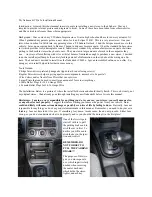
Functional Units
The PU4 module consists of the following functional units:
•
Internal power supply
•
Controller
•
Analog line interfaces with digital signal processor
•
Digital line equipment, which intercommunicates via an interface
•
Ethernet EN100 module (optional)
Internal Power Supply
The internal power supply generates the voltages needed on the module that are not fed externally:
•
Supply voltages for the analog line interface
•
Switched 12 V supply voltage for the relays on the IFC modules
The 12 V operating voltage for the IFC modules can be switched from the controller and allows selective disa-
bling of the output relays. The operating voltages on the module are monitored. Loss of a voltage generates a
reset and an alarm on the module.
Controller
The controller is the central element of the PU4. It controls communication with the analog line interface, the
digital line unit, the local (service) interface for the service PC, the LAN, and the alarm interface. You can load
equipment variants and user data via the local interface or via the iLAN interface. The service program
PowerSys is responsible for the administration of the possible equipment variants for the DSP.
The controller carries out the entire administration of memory space. The following memory chips are avail-
able:
•
NV-RAM for event recorder
•
SRAM for working memory
•
FPROM for program memory
The controller also implements the data exchange in the transmit and receive direction with the interface
module IFC-D/P and IFC-S. The controller reads the data from the IFC module, which is fed via an input buffer
into a register. The controller writes the data relating to the IFC module also into this register per interrupt.
The data reaches the IFC module via an output buffer.
If an error is detected in the SWT 3000 unit, a message to this effect is output via an interface to the alarm
module ALR. If the PU4 is used in PowerLink, the alarms are forwarded to the CSPi and the alarm is output on
the ALR module of PowerLink.
Analog Line Interface
The LIA sets up the connection of the module to the analog protection command transmission and consists of
a DSP, operational amplifiers, and analog switches.
DSP generates the necessary command frequencies and communicates with the transmission interfaces.
Depending on the equipment variant, these transmission interfaces are the interfaces to the Intermediate
Frequency (IF) modules or to the CLE.
All necessary information is loaded with the equipment variant via the service program. The controller writes
the information into the DSP via an interface. During operation, this interface is used to transmit protection
commands and parameters. The controller can read and write DSP memory cells, and can also transfer
commands and trigger various interrupts.
7.1.2
7.1.3
7.1.4
7.1.5
Processing Unit Module
7.1 Functions of the PU4 module
312
Smart Communication, SWT 3000 Teleprotection, Equipment Manual
C53000-G6040-C605-1, Edition 03.2020
















































